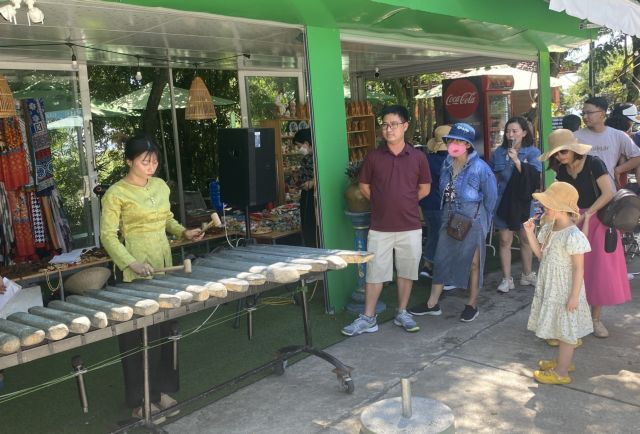 Sunday/Weekend
Sunday/Weekend

 |
| TUNE IN: Local young people in ethnic costume play the lithophone at the Hồn Xưa cultural space in Gành Đá Đĩa Special National Heritage site in Phú Yên. VNA/VNS Photo Tường Quân |
Lithophone (or đàn đá in Vietnamese) is a rare ancient musical instrument typical of the mountain areas of the central province of Phú Yên.
The stone musical instrument, related to the xylophone, is one of the world's oldest, and has recently been attracting the attention of local youngsters eager to play at provincial tourist destinations such as Gành Đá Đĩa (Cliff of Stone Plates) and Tháp Nhạn (Nhạn Tower).
The clear melodies usually revolve around local songs, like the one featured in the film Tôi Thấy Hoa Vàng Trên Cỏ Xanh ((Yellow Flowers on Green Grass), which have been a big draw for visitors left fascinated by the strange ancient instrument.
Young performers often gather at the Hồn Xưa cultural space located at the Gành Đá Đĩa Special National Heritage site to practise on the lithophone, as well as join modern music bands to play popular Vietnamese folk songs.
The idea to put on a local lithophone performance was first aired by Nguyễn Minh Nghiệp, a musician at Hồn Xưa. Nghiệp has had a passion for the instrument for a decade, and has been collecting stone slabs, which the instrument consists of, in his home district of Tuy An since 2013.
"I spend much of my time studying the instrument's structure so that I can create full musical notes and the clearest sounds," he said.
 |
| ANCIENT INSTRUMENT: Visitors interested in a lithophone performance at the Tháp Nhạn Special National Heritage site. VNA/ VNS Photo Tường Quân |
In early 2017, Nghiệp's idea to bring and perform his lithophone at tourist attractions in Phú Yên received a good response from many visitors, and he was supported by the local authorities and the artist community to continue the work. Along with organising lithophone performances, he runs classes to train young people to play the instrument.
Nguyễn Thị Ngọc Hiền, one of the young performers at Hồn Xưa, said that she needed one to two months to practise before a regular show, but to perform well and with soul, she needed between four and five months of learning from senior artists.
"A good performer must have love and be passionate so that he or she can be immersed in the sound of the instrument," Hiền said
She hopes that more and more tourists will visit Phú Yên to enjoy the landscape and learn more about the instrument. She plans to put on more shows to entice tourists.
 |
| ROCKING OUT: Dr Katherine Muller Marin, head of UNESCO Việt Nam trying the sound of a Tuy An lithophone.Photo baophuyen.vn |
Musician Mike Adcock has been fascinated by Vietnamese lithophones for years.
"I made my second visit to Việt Nam and my reason for going was again a musical one, summed up in one word: stone. For more than twenty years now, I've had a thing about the way in which certain cultures of the world have chosen to produce music from this most unpromising of materials. Certain types of rock will ring when struck and, depending on length and thickness, can produce notes of identifiable pitch," he told Roots World magazine.
"It was Việt Nam which really put lithophones on the map internationally. In 1949, some villagers in the Central Highland region unearthed a set of stone slabs and brought them to the attention of a French ethnologist living there at the time, who reckoned they were a form of ancient musical instrument, promptly had them sent to Paris for further investigation and that's where they have remained, in the Musée de l'Homme, to this day."
Bùi Thị Giang, a tourist from the northern province of Hòa Bình, said that she and her family were very impressed by the local performances when she recently visited Gành Đá Đĩa with her family.
"Each stone slab can produce standard, pure and clear melodies, very different from other types of instruments in other localities," Giang said.
Public lithophone performances are also held at Tháp Nhạn Special National Heritage site in Tuy Hòa City. The melodious sounds resound in the quiet, ancient space among the Chăm towers, making the tourist experience more profound.
Nghiệp said in the near future, he and many local young people would participate in more cultural and art performance tours to other provinces across the country.
"I will try to find and make more lithophones with good quality, and at the same time train more young people to play them, as a way of contributing to and promoting the values of this unique art," Nghiệp said.
Musician Adcock remembered being surprised and stunned when first hearing one of Nghiệp's instruments, purely by chance.
"Taking an afternoon walk through the woodland park of Nhạn Mountain, on our way to see the renowned Champa temple situated there, I heard what seemed like the sound of a lithophone being played coming through the trees. At first, I thought I was imagining it, some kind of wishful thinking, perhaps. Then sure enough, there it was," Adcock said.
"A young woman, dressed in pink and sporting the ubiquitous conical hat stood behind a lithophone playing tunes to a pre-recorded accompaniment. It had been built by a man called Nguyễn Minh Nghiệp who runs the nearby gift shop and talking to him later we learnt that he'd built a number of such instruments, tuning them by ear despite having had no musical training. Nghiệp invited us to drive with him the following day to an ancient heritage centre he had opened, displaying his collection of old domestic artefacts as well as more of his lithophones. Again, there were young players on hand to give a performance of popular Vietnamese songs and melodies."
According to Nguyễn Hữu An, director of the Phú Yên Province Museum, the first set of ancient lithophone in the province was found in 1990 in Tuy An District by a resident who gave the ancient instrument to the museum in 1992.
After receiving it, the province established a scientific council, which identified this ancient stone musical instrument to 2,500 years ago, An said.
The provincial Department of Culture, Sports and Tourism directed the museum to compile a dossier and submit it to the Ministry of Culture, Sports and Tourism to recognise the Tuy An lithophone as a national treasure. Work on its status is still ongoing.
The Phú Yên People's Committee organised a meeting to introduce and demonstrate the national cultural value of Tuy An lithophones to UNESCO Việt Nam in 2012. Dr Katherine Muller Marin, the then head of UNESCO in Việt Nam, said she appreciated the particular features of the lithophone, particularly the harmonious and smooth sounds it made.
In 2020, Tuy An lithophones were assessed to possess the most standard sound scales among all pre-historic lithophones discovered in Việt Nam.
Tuy An lithophones are considered national treasures, and UNESCO in Việt Nam has suggested they need to be studied further. VNS